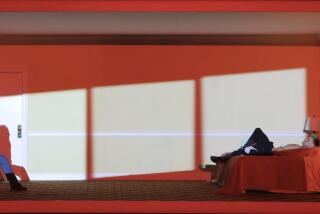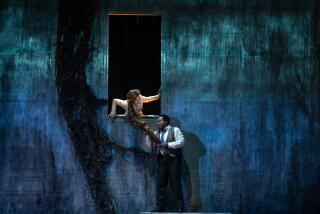MUSIC AND DANCE REVIEWS : ALLARD CONDUCTS
- Share via
Gathering all the right elements and rehearsing all the many parts are the basic business of mounting a work as complex and monumental as Bach’s “St. Matthew” Passion. In the basics, conductor Maurice Allard seems to have made many good moves in putting together the semi-staged performance of the Passion that was given Saturday in Segerstrom Hall at the Orange County Performing Arts Center.
Making it all work is the crucial matter. Vision, concept and details have to mesh; the separate entities must complement each other; tempos need justifying and relating; musical and dramatic continuity require planning, pacing, fitting.
When it was completed, just before nine o’clock--the performance had begun at four and had been broken by a dinner intermission--this “St. Matthew” Passion earned admiration for the success of some of its ingredients. But the total fell short.
A squareness and lack of buoyancy in Allard’s conducting kept much of the performance earthbound; with stronger contrasts of dynamics and meter, the spiritual elements might have come into play more convincingly.
Though the conductor’s dividing the 140-member Master Chorale into two smaller--if hardly tiny--half-choirs sometimes lightened the choral textures, he seldom achieved true lightness, never mind Baroque transparency. And most of Allard’s tempos--many seemed pushed, a few slowish--were weakened by an evenness of accent which made them all appear to plod.
Most distressing, the well-trained Chorale, admirably careful in the areas of intonation and balance, often proved less precise in enunciation; words did not project as well as tone from the Segerstrom stage to the Segerstrom audience, and many words simply could not be understood.
Orchestral matters followed a similar pattern. Willing and virtuosic as the players were, well-defined contrasts seldom materialized. Most often, soft playing came out a couple of levels louder than ideal. Still, individual soloism inhabited a high plateau, especially from, among others, violinist Ralph Morrison, flutist David Shostac and cellist John Walz.
Wearing stylized, Biblical-era costumes, the 16 vocal soloists enacted effective and simple, but not simplistic, stage maneuvers devised by Susan Lee on a series of seven platforms behind the orchestra and in front of the chorale.
Jon Humphrey was the impassioned, in moments poignant, Evangelist; Kenneth Cox, a noble, stoical and sometimes grainy-sounding Jesus. Alison England, Elizabeth Mannion, David Jolly and Rodney Gilfry sang their arias stylishly and with strong musicality; Gilfry in particular produced a combination of rich tone and textual point. The subsidiary singers moved well; vocally, they ranged from highly promising to merely serviceable.
More to Read
The biggest entertainment stories
Get our big stories about Hollywood, film, television, music, arts, culture and more right in your inbox as soon as they publish.
You may occasionally receive promotional content from the Los Angeles Times.










